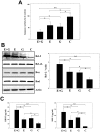Granulocyte colony-stimulating factor activating HIF-1alpha acts synergistically with erythropoietin to promote tissue plasticity
- PMID: 20404921
- PMCID: PMC2852409
- DOI: 10.1371/journal.pone.0010093
Granulocyte colony-stimulating factor activating HIF-1alpha acts synergistically with erythropoietin to promote tissue plasticity
Erratum in
- PLoS One. 2010;5(10). doi:10.1371/annotation/433064f4-e30a-4000-8e5a-9e8d1775d820. Su, Ching-Yuan [added]; Li, Hung [added]
Abstract
Stroke and peripheral limb ischemia are serious clinical problems with poor prognosis and limited treatment. The cytokines erythropoietin (EPO) and granulocyte-colony stimulating factor (G-CSF) have been used to induce endogenous cell repair and angiogenesis. Here, we demonstrated that the combination therapy of EPO and G-CSF exerted synergistic effects on cell survival and functional recovery from cerebral and peripheral limbs ischemia. We observed that even under normoxic conditions, G-CSF activates hypoxia-inducible factor-1alpha (HIF-1alpha), which then binds to the EPO promoter and enhances EPO expression. Serum EPO level was significantly increased by G-CSF injection, with the exception of Tg-HIF-1alpha(+f/+f) mice. The neuroplastic mechanisms exerted by EPO combined with G-CSF included enhanced expression of the antiapoptotic protein of Bcl-2, augmented neurotrophic factors synthesis, and promoted neovascularization. Further, the combination therapy significantly increased homing and differentiation of bone marrow stem cells (BMSCs) and intrinsic neural progenitor cells (INPCs) into the ischemic area. In summary, EPO in combination with G-CSF synergistically enhanced angiogenesis and tissue plasticity in ischemic animal models, leading to greater functional recovery than either agent alone.
Conflict of interest statement
Figures






References
-
- Wang L, Zhang Z, Wang Y, Zhang R, Chopp M. Treatment of stroke with erythropoietin enhances neurogenesis and angiogenesis and improves neurological function in rats. Stroke. 2004;35:1732–1737. - PubMed
-
- Signore AP, Weng Z, Hastings T, Van Laar AD, Liang Q, et al. Erythropoietin protects against 6-hydroxydopamine-induced dopaminergic cell death. J Neurochem. 2006;96:428–443. - PubMed
-
- Frampton JE, Lee CR, Faulds D. Filgrastim. A review of its pharmacological properties and therapeutic efficacy in neutropenia. Drugs. 1994;48:731–760. - PubMed
-
- Lee ST, Chu K, Jung KH, Ko SY, Kim EH, et al. Granulocyte colony-stimulating factor enhances angiogenesis after focal cerebral ischemia. Brain Res. 2005;1058:120–128. - PubMed
-
- Park HK, Chu K, Lee ST, Jung KH, Kim EH, et al. Granulocyte colony-stimulating factor induces sensorimotor recovery in intracerebral hemorrhage. Brain Res. 2005;1041:125–131. - PubMed
Publication types
MeSH terms
Substances
LinkOut - more resources
Full Text Sources
Research Materials
Miscellaneous

